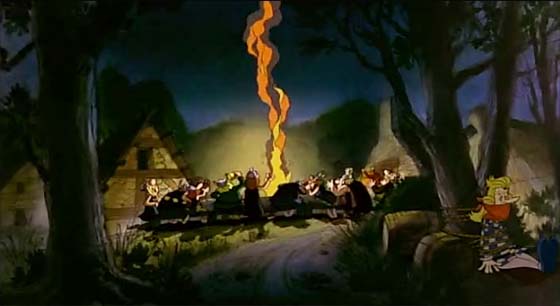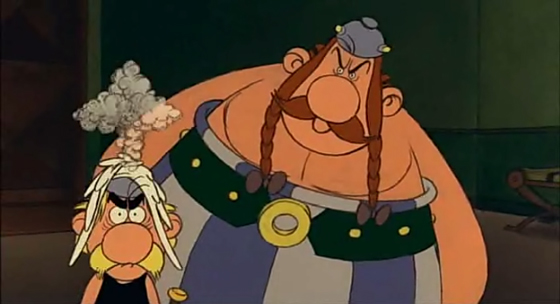
It’s eternally odd to me that Asterix the Gaul is relegated to mere cult status here in America. It seems that everywhere else on the planet he’s as iconic as Mickey Mouse – he even has his own theme park in France – but in this stubborn New World, Asterix has long been as obscure as Tintin, for whom not even a Steven Spielberg movie could quite bring the (elsewhere famous) comic book character to household name status. I can’t help but think of the culturally ignorant contestants on last season’s The Amazing Race, who were asked to dress up as two characters from the Tintin books, and then try to determine who they were by asking random Belgians. The answer was Thomson and Thompson (or, in the original French, Dupont and Dupond), though one couple submitted their answer as that great comic team, “Charlie Chaplin and Charlie Chaplin.” When I was a child growing up in California, Tintin and Asterix were, tantalizingly, just barely accessible. I would visit the library and get a thrill whenever one of their books was on the shelves. I loved them both, but Asterix connected like a magic-potion-powered punch. The irreverent humor, the ancient Rome setting, the appealing artwork and clever layouts of Albert Uderzo, the rich comic plots and nonstop puns of René Goscinny…I was in love. And the fact that I was in a long-distance relationship (with a comic book from France that was damn difficult to find on these shores) only made me all the more lovesick. In my teenage years, I lucked into a giant stack of Asterix books in a local used bookstore, and bought them all. Periodically I still return to that stack, and the stories of Goscinny & Uderzo have aged well. Now you can click on Amazon.com and have a wealth of Asterix available to you. But this is a different age, where the rich taste of discovery has been watered down, measured by points and clicks.
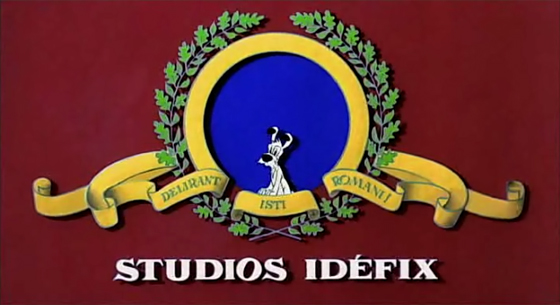
The MGM-inspired logo for Goscinny and Uderzo's Studios Idéfix.
But bless Amazon for this: now I once more own The Twelve Tasks of Asterix (1976), thanks to an imported DVD shipped over from the U.K. All right, it lacks special features, and only contains the English dub, but the dub is well done, and this is the version I grew up with, having taped it off the Disney Channel as a child and watched it repeatedly. (It’s also anamorphic widescreen, which I care about a lot more than extras.) The Disney Channel – back in the 80’s, when it consisted primarily of Disney films and cartoons – used to run all the Asterix animated films, and it was easy to compare them directly and see that the 1976 film was the best (Disney also released the film on VHS; I have no idea if they still own the rights for U.S. distribution, though it would explain why it hasn’t resurfaced here). There’s a reason why Twelve Tasks stuck out from the crowd. Goscinny & Uderzo co-wrote and co-directed the film through their short-lived animation studio, Studios Idéfix; a cute brand logo at the start of the film features little Dogmatix yapping away in parody of the MGM lion. Unlike the two earlier Asterix animated films, Asterix the Gaul (1967) and Asterix and Cleopatra (1968), the Gaul’s third cinematic outing takes full advantage of the animated form. The visual gags are fast and furious, and successfully exploit a more Chuck Jones-styled humor to suit the medium.
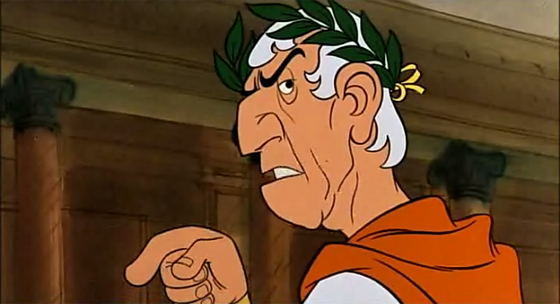
"Brutus, stop playing about with that knife. You'll end up hurting somebody!"
Asterix (in the English dub, ideally voiced by British comedian Bill Oddie) and his faithful companion Obelix help defend their Gaulish village from the Roman Empire with the help of the druid Getafix’s magic potion. To those new to the franchise, you only need to know that Asterix is small but clever, and Obelix – whose strength is permanently enhanced from having fallen into the potion as a baby – is large but dim-witted. Julius Caesar, frustrated by the constant humiliation provided by the Gauls, presents chief Vitalstatistix with a challenge: if his finest champions can successfully perform twelve impossible feats, Hercules-style, then he will surrender all of Rome. Asterix and Obelix set forth at once, guided by the mousy Roman envoy Caius Tiddlus; thus begins a most episodic adventure in which each task becomes a comic vignette with its own unique style. The fun lies in discovering what the task will be, and then trying to deduce how Asterix and Obelix will overcome it.
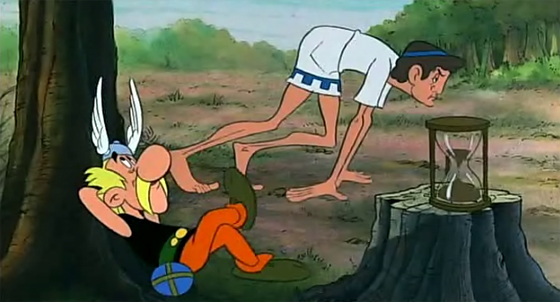
In his first task, Asterix prepares to race the fastest man alive.
Rewatching the film after so many years, I’m pleased to see it holds up pretty well. The animation is rough in a few places (particularly in some of the earlier sequences), but for the most part is a vast improvement over earlier Asterix efforts, and is pleasingly exaggerated in the finest Looney Tunes tradition – notably in the first task, a race against the fastest man alive, in which his anatomy takes on increasingly absurd proportions, until he finally transforms into a rocket; in an homage to Chuck Jones, the film even shatters against the strain, revealing a white nothingness behind it. In the film’s denouement, which rewrites history in the manner of Inglourious Basterds, Asterix openly confesses that they can do anything: “it’s only a cartoon movie!”…which prompts the delighted Obelix to violate one last narrative rule. You could also call the film’s humor Pythonesque, which is perhaps one of the reasons why the British dub isn’t so distracting. In a delightful moment, a solemn old man at the top of a mountain smoothly segues his speech into a pitch for Olympus-brand detergent, which allows Goscinny & Uderzo to cut to Mount Olympus and an efficient parody of the pantheon of Roman gods. A comic highlight is the visit to “the place that sends you mad,” a Roman office building in which our heroes are tasked with obtaining Permit A-38. They quickly find themselves in a bureaucratic knot worthy of Monty Python, and foreshadowing Terry Gilliam’s Brazil (1985); like Sam Lowry, Asterix fights back by turning the system against itself, giving it the smallest nudge to allow it to implode.
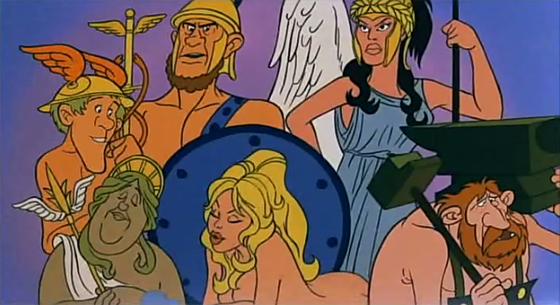
The Roman gods, as portrayed by Uderzo.
Perhaps it was just the 70’s, but it’s hard not to detect a note of Ralph Bakshi here and there, in particular during the task where Asterix and Obelix must survive “the Cave of the Beast,” a funhouse of horrors to which they must even obtain a ticket. The environment they enter is the most experimental sequence in the film, with a bag of tricks that includes mixing live action with animation, a la Fritz the Cat (1972) and Heavy Traffic (1973). Though it never quite rises above the G-level, there are hints of adult sexuality, such as the partial nudity of the film’s briefly-glimpsed Venus, and the feminine temptations of the Isle of Pleasure, where large-breasted, scantily-clad vixens express surprise that Obelix desires nothing more than to feast on wild boar. But then, Uderzo’s women were always a lot more alluring than Hergé’s. The film does show its age with a disco-music dance on the Isle of Pleasure, and the overbearing main theme by Gérard Calvi, but despite a few caveats, The Twelve Tasks of Asterix remains a notable animated film of the 70’s, succeeding in its intention to create an original Asterix graphic novel for the big screen directly from the character’s creators. Goscinny died the year following its release, and Studios Idéfix was disbanded. It wouldn’t be until 1985 that Asterix returned to European cinemas, and big-budget, live action films finally arrived beginning in 1999, with all-star casts and elaborate FX. Unsurprisingly, they have yet to be released in the U.S.
